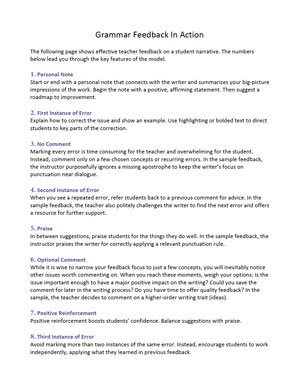
Commenting on grammar issues in student writing presents a tricky teaching situation. You don’t want students to flounder without support, but you also don’t want them to drown in red corrections.
Thankfully, a happy middle ground exists.
Follow these tips to deliver quick, effective grammar feedback. Then download the free resource to see the advice in action.
1. Choose the right time.
Early in the writing process, students should focus on the ideas, organization, and voice of their writing—and so should your feedback. Save grammar comments for when students reach the editing step. But don’t delay too long. If your feedback comes after students submit their final draft, they will miss an opportunity to apply what they learned.
2. Choose the right method.
Write your feedback directly on students’ work. When working with printed copies, write in the margins using a different color than the text. (Avoid red pens.) For digital copies, use the “Review” or "Comments" tool on your word processor. You might also experiment with voice comments.
When possible, provide verbal feedback through peer-review discussions and conferences.
3. Narrow your focus.
Overcorrecting discourages students and offers little learning value. It’s also inefficient; marking every mistake will sap your time, energy, and spirit. Instead, concentrate on one or two concepts or objectives. That way students build skills and apply rules one at a time, and you review their work more efficiently.
4. Use an encouraging tone.
Keep your feedback comments polite and positive. Focus on solutions instead of criticism.
5. Watch for recurring errors.
Most repeated errors occur when a student internalizes an unconventional “rule” that he or she believes is standard. (This phenomenon happens when ELL writers apply a rule from their first language to English writing.)
Uncover the logic behind the pattern, draw attention to it, and offer a remedy. You will do the student a great service.
6. Start with direct feedback.
Mark the first instance of an error at the point-of-use. In the margin, explain how to correct the error and show a sample correction. Use highlighting, underlining, or bolded text to direct the student to key parts of the correction.
7. Transition to indirect feedback.
When you notice a repeated error, refer students back to an earlier comment or a grammar resource for a solution. Do not mark the same type of error more than twice. Encourage students to discover and fix subsequent errors independently.
8. Balance suggestions with praise.
Praise students for things they do well, especially when they apply concepts from recent lessons.
9. Reinforce skills with extra practice.
If you notice multiple students making the same error, present a minilesson and practice activity to reinforce the skill.
